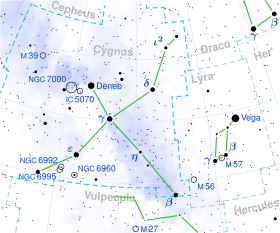Nu Cygni
Appearance
(Redirected from Ν Cygni)
| Observation data Epoch J2000 Equinox J2000 | |
|---|---|
| Constellation | Cygnus |
| Right ascension | 20h 57m 10.41907s[1] |
| Declination | 41° 10′ 01.6991″[1] |
| Apparent magnitude (V) | 3.94 [2] |
| Characteristics | |
| Spectral type | A0III n[3] |
| U−B color index | +0.00[2] |
| B−V color index | +0.02[2] |
| Astrometry | |
| Radial velocity (Rv) | −27.60[4] km/s |
| Proper motion (μ) | RA: +9.64[1] mas/yr Dec.: −22.75[1] mas/yr |
| Parallax (π) | 8.71 ± 0.34 mas[1] |
| Distance | 370 ± 10 ly (115 ± 4 pc) |
| Absolute magnitude (MV) | −1.36[5] |
| Details | |
| ν Cyg A | |
| Mass | 3.62±0.08[6] M☉ |
| Radius | 7.55[6][a] R☉ |
| Luminosity | 412[6] L☉ |
| Temperature | 9,462[6] K |
| Rotational velocity (v sin i) | 217[6] km/s |
| Other designations | |
| Database references | |
| SIMBAD | data |
Nu Cygni, Latinized from ν Cygni, is a binary star[8] system in the constellation Cygnus. Its apparent magnitude is 3.94[2] and it is approximately 374 light years away based on parallax.[1] The brighter component is a magnitude 4.07 A-type giant star with a stellar classification of A0III n,[3] where the 'n' indicates broad "nebulous" absorption lines due to rapid rotation. This white-hued star has an estimated 3.6 times the mass of the Sun and about 7.55 times the Sun's radius. It is radiating 412 times the Sun's luminosity from its photosphere at an effective temperature of 9,462 K.[6] The magnitude 6.4 companion has an angular separation of 0.24" from the primary.[8]
Notes
[edit]- ^ Radius calculated using temperature and luminosity
References
[edit]- ^ a b c d e f van Leeuwen, F. (2007). "Validation of the new Hipparcos reduction". Astronomy and Astrophysics. 474 (2): 653–664. arXiv:0708.1752. Bibcode:2007A&A...474..653V. doi:10.1051/0004-6361:20078357. S2CID 18759600. Vizier catalog entry
- ^ a b c d Ducati, J. R. (2002). "VizieR Online Data Catalog: Catalogue of Stellar Photometry in Johnson's 11-color system". CDS/ADC Collection of Electronic Catalogues. 2237: 0. Bibcode:2002yCat.2237....0D.
- ^ a b Abt, Helmut A; Morrell, Nidia I (1995). "The Relation between Rotational Velocities and Spectral Peculiarities among A-Type Stars". Astrophysical Journal Supplement. 99: 135. Bibcode:1995ApJS...99..135A. doi:10.1086/192182. Vizier catalog entry
- ^ Gontcharov, G. A. (November 2006). "Pulkovo Compilation of Radial Velocities for 35 495 Hipparcos stars in a common system". Astronomy Letters. 32 (11): 759–771. arXiv:1606.08053. Bibcode:2006AstL...32..759G. doi:10.1134/S1063773706110065. S2CID 119231169.
- ^ Anderson, E.; Francis, Ch. (2012), "XHIP: An extended hipparcos compilation", Astronomy Letters, 38 (5): 331, arXiv:1108.4971, Bibcode:2012AstL...38..331A, doi:10.1134/S1063773712050015, S2CID 119257644.
- ^ a b c d e f Zorec, J.; Royer, F. (January 2012), "Rotational velocities of A-type stars. IV. Evolution of rotational velocities", Astronomy & Astrophysics, 537: A120, arXiv:1201.2052, Bibcode:2012A&A...537A.120Z, doi:10.1051/0004-6361/201117691, S2CID 55586789.
- ^ "* nu. Cyg". SIMBAD. Centre de données astronomiques de Strasbourg. Retrieved 11 March 2017.
- ^ a b Eggleton, P. P.; Tokovinin, A. A. (September 2008), "A catalogue of multiplicity among bright stellar systems", Monthly Notices of the Royal Astronomical Society, 389 (2): 869–879, arXiv:0806.2878, Bibcode:2008MNRAS.389..869E, doi:10.1111/j.1365-2966.2008.13596.x, S2CID 14878976 Vizier catalog entry

